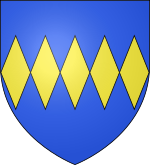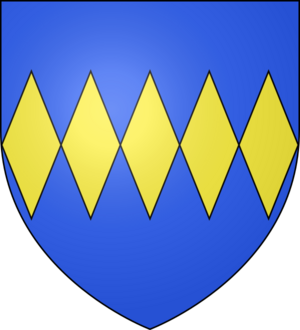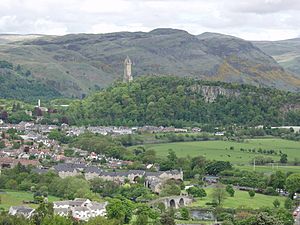Henry Percy, 1st Baron Percy facts for kids
Quick facts for kids
Henry de Percy
|
|
|---|---|
| Ordinancer | |
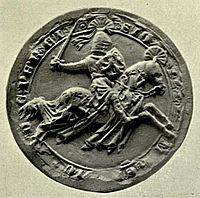
Seal of Henry Percy from the Barons' Letter, 1301. On his shield he bears the arms of Brabant (Percy modern)
|
|
| Successor | Henry de Percy, 2nd Baron Percy |
| Born | 25 March 1273 Petworth, Sussex, England |
| Died | 2–10 October 1314 (aged 41) Alnwick, Northumberland, England |

Henry de Percy, 1st Baron Percy of Alnwick (born 1273 – died 1314) was an important English nobleman in medieval times. He was known for his military skills and for helping to establish the powerful Percy family in northern England.
Henry fought for King Edward I in Wales and Scotland. He gained a lot of land in Scotland, but the Scots later took it back. He also bought Alnwick Castle, which became a key family home. Henry later had disagreements with King Edward II and was even put in prison for a short time. He died at age 41.
Contents
- Henry's Early Life and Family
- Becoming an Adult and Changing His Family Arms
- Marriage and Children
- Becoming a Knight and Fighting in Scotland
- Becoming a Baron and Scottish Landowner
- A New King and New Challenges
- Building a Family Base in Northumberland
- The Return of Gaveston and Baron Conflicts
- Imprisonment and Release
- Henry Percy's Final Year
Henry's Early Life and Family
Henry was born in 1273 at Petworth House in Sussex, England. He was born seven months after his father passed away. This was important because his older brothers had died young, and his uncles had no children. This meant Henry was the only one to continue the family name.
His mother was Eleanor de Warenne. Her father, John de Warenne, 6th Earl of Surrey, was a very powerful nobleman. Henry's family had been important landowners for a long time.
Becoming an Adult and Changing His Family Arms
In 1293, Henry officially took control of his family's lands. These lands were in Sussex and Yorkshire, and included Topcliffe Castle. In 1294, he married Eleanor, whose father was the Earl of Arundel.
Around this time, Henry changed his family's coat of arms. The old arms were blue with five gold diamond shapes. The new arms were a blue lion on a gold background. This new design was similar to the arms of his powerful grandfather, Earl Warenne, and his wife's family, the Arundels. This change showed his ambition and his strong connections to other noble families.
That same year, Henry went to war for the first time. He was called to fight in France but was sent to Wales instead. There, he helped King Edward I stop a Welsh rebellion. This was where he learned about leading armies and fighting battles.
Marriage and Children
Henry de Percy married Eleanor FitzAlan. They had two sons:
- Henry de Percy, 2nd Baron Percy (born 1299), who became the next Baron Percy.
- William de Percy (around 1303–1355).
Becoming a Knight and Fighting in Scotland
By 1295, Henry was in northern England with his grandfather, Earl Warenne. King Edward I's harsh treatment of Scotland was leading to war. In March 1296, Edward I's army attacked Berwick on Tweed, a large Scottish port. On March 30, Henry Percy was made a knight by the King himself. Later that day, the English captured the town.
Percy then helped capture Dunbar Castle. Soon, all of Scotland was under English control. Henry Percy was put in charge of areas like Ayr and Galloway, based at Carlisle Castle.
However, peace didn't last long. In 1297, William Wallace started a Scottish uprising. Other Scottish nobles, including Robert Bruce, also joined the fight. Henry Percy helped put down some of these rebellions in southern Scotland.
Later, at the Battle of Stirling Bridge, the English army suffered a terrible defeat. Percy and other commanders could only watch as their soldiers were trapped and killed. The Scots then raided northern England. In 1298, King Edward returned with a large army. They met Wallace at the Battle of Falkirk, where Henry Percy fought as part of the cavalry.
Becoming a Baron and Scottish Landowner
In 1299, King Edward gave Henry Percy lands in England and Scotland. This made Henry richer and more important. The King also called Henry to attend parliament, making him a baron. Before this, his family had been called barons because of their land, but now it was an official title.
Henry continued to fight in Scotland. In 1304, he helped negotiate a peace agreement between the Scots and the English king. Only Stirling Castle remained to be captured. The English used giant catapults, including one called Warwolf, to break down its walls.
In 1305, a joint English and Scottish parliament met to create a new government. Henry Percy played a big part in these talks. However, Robert Bruce was already planning another rebellion. When Bruce was crowned King of Scotland in 1306, Edward I gave Bruce's lands to Henry Percy. Percy was ordered to crush the rebellion. Bruce's army was defeated, but he continued to fight a guerilla war from the wild countryside.
A New King and New Challenges
King Edward I died in 1307 while on his way to fight the Scots again. His death was a problem for Henry Percy. Percy had fought hard and gained much land in Scotland. But the new king, Edward II, was more interested in his friend Piers Gaveston.
Edward II brought Gaveston back to England, even though his father had banished him. Gaveston was given a lot of power and openly insulted the old king's loyal warriors. Edward II also replaced his father's experienced commanders, including Percy.
Robert Bruce took advantage of this. He raised new forces and raided northern England. Percy and other nobles were called back to defend the borders. In 1308, Percy attended Edward II's coronation. There, Gaveston was given special treatment, which angered many nobles. The barons forced the king to send Gaveston away, but he soon returned.
Building a Family Base in Northumberland
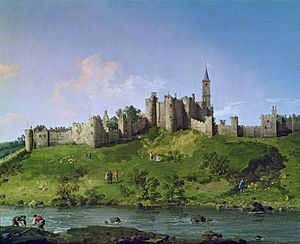
In 1309, Henry Percy bought Alnwick Castle from the Bishop of Durham. This castle was very important because it was close to the Scottish border. It also brought him a lot of money from its lands. To buy it, he borrowed money from Italian bankers. This purchase helped establish the Percy family as a major power in northern England.
The Return of Gaveston and Baron Conflicts
By 1309, King Edward II had allowed Piers Gaveston to return to England again. Gaveston continued to insult the powerful earls, making them even angrier. Henry Percy tried to stay out of these conflicts, focusing on his new castle at Alnwick.
In 1310, the King was forced to agree to a group of twenty-one nobles, called the Lords Ordainers, who would help govern the country. Percy fought in the King's campaign in Scotland that year, but little was achieved because Robert Bruce avoided direct battles.
In 1311, Gaveston ordered Percy to hold the town of Perth with only a small force. This was a dangerous task, but Percy survived. The barons then forced the King to send Gaveston away again. But Gaveston was soon recalled and given back his lands.
In April 1312, an army led by the Earl of Lancaster, Percy, and Clifford chased the King and Gaveston out of Newcastle. They fled to Scarborough Castle. Percy and others then besieged Gaveston at Scarborough. Gaveston surrendered and was later executed by the angry earls.
Imprisonment and Release
King Edward II was furious about Gaveston's death. He didn't start a civil war, but he punished less powerful nobles like Henry Percy. On July 28, 1312, Percy's lands were taken away, and he was put in prison.
The other earls made Percy's release a top priority in their talks with the King. Henry Percy was freed in January 1313 and officially pardoned in October.
Henry Percy's Final Year
In 1314, King Edward II prepared for another campaign in Scotland. This led to his huge defeat at the Battle of Bannockburn. Henry Percy, along with many other nobles, refused to join this campaign. They believed the King had not followed the rules set by the Ordinances.
It seems Henry Percy stayed at Alnwick, defending his lands from Scottish raids. His friend, Robert Clifford, did go to Bannockburn and was killed there.
Just days after the battle, Percy was called to Newcastle to help defend northern England from a possible Scottish invasion. Instead of a full invasion, Robert Bruce sent raiding parties to demand money from the northern counties. Henry Percy died a few months later, in October 1314, at the age of 41. The cause of his death is not known.


